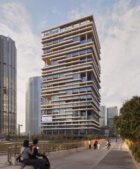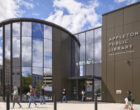Fast Company recently profiled SOM’s new Shenzhen headquarters for WeBank, highlighting how the 30-story tower challenges the sealed-glass model of most high-rise office buildings. As Nate Berg writes, the project “punches holes right through this convention,” replacing the typical sealed tower with a climate-responsive, wellness-driven alternative.
As China’s first digital-only bank, WeBank wanted a modern workplace centered around flexibility and occupant health. Rather than maximizing height, SOM designed expansive, open floor plates that support adaptable layouts and provide outdoor access on every floor. Multi-story atria serve a dual role as vertical ventilation shafts and communal spaces that foster collaboration and connectivity across teams.
These atria, which Berg compares to “the voids inside a block of Swiss cheese,” are carefully shaped to control how air flows in and out of the building. Design Partner Scott Duncan explains that this design allows for airflow through and across levels, emphasizing the role of the stack effect in refreshing interior air. But it’s not just the meticulously engineered indoor atria that creates an outdoor connection, it’s also the open-air terraces, rooftop gardens, and operable windows. “There aren’t that many buildings out there at this height that have this degree of indoor-outdoor space,” he said.
This natural ventilation provides tangible health and wellness advantages. According to Luke Leung, sustainable engineering lead, the building has up to six air changes every hour. Within 30 minutes, it can remove 95 percent of contaminants from a floor using natural means.
Through integrating fresh air, abundant daylight, and adaptable floor plates, WeBank Headquarters reimagines tall buildings as a breathable and flexible workplace, maintaining comfort while reducing dependence on mechanical cooling.





